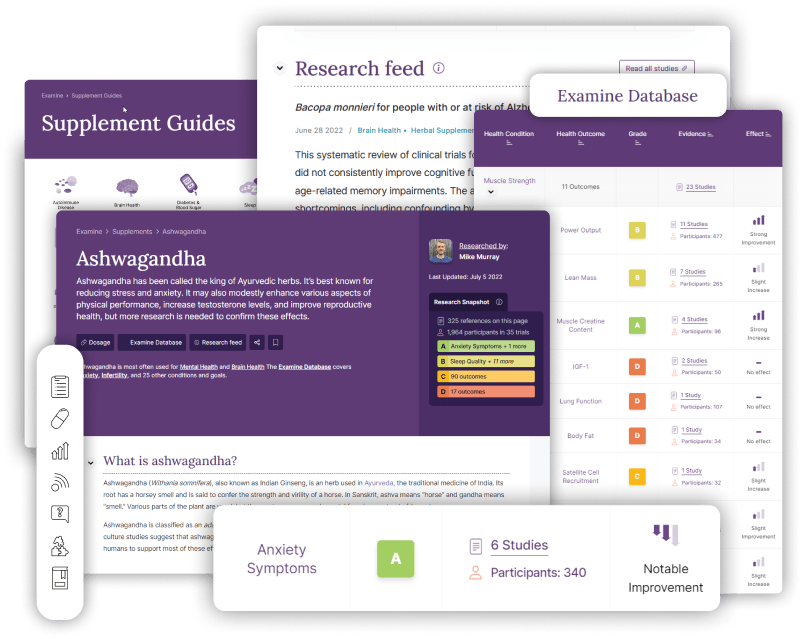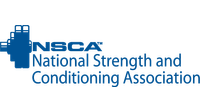Learn what works
The Examine+ membership unlocks everything on the site.
Supplement Guides
What works and what doesn’t? We wrote step-by-step guides with all the practical information you need (dosage, safety, synergies, and more).
Learn moreExamine Database
What does the body of evidence say? We graded hundreds of supplements and other health interventions for thousands of health outcomes, based on evidence from randomized trials.
Learn moreResearch Feed
What does the latest evidence say? We continuously summarize the most important new studies on the health topics you select.
Learn more
Over 15,000 members rely on Examine+ for unbiased nutrition information, including at the following companies:
“This is an absolutely phenomenal site. It’s one that I rely on, and that I know thousands, if not millions of other people rely on. I encourage you to check it out.”
Professor and Neuroscientist at Stanford University and Host of the Huberman Lab Podcast
Dr. Andrew Huberman
We are your team. Since our founding in 2011, we’ve
operated with no conflicts of interest:
On your side since 2011,
with no conflicts of interest:
No investors or sponsors to answer to.
We don’t sell supplements or even ad space on our website.
No parent company telling us what to do.
We don’t recommend brands or specific products.
Each of us is contractually required to have zero industry ties.
All this explains why Examine is a trusted source of information for top professionals (doctors, dietitians, coaches, athletes, etc.), top health organizations (such as the Academy of Nutrition and Dietetics and the National Academy of Sports Medicine), the mainstream media (such as The New York Times and The Guardian), and tens of millions of people all over the world, each with their own health concerns and health goals.
What is the plus of Examine+?
There isn’t just one plus to Examine+ —
there are three!
- 1
Combos
- 2
Primary Supplements
- 3
Secondary Supplements
- 4
Promising Supplements
- 5
Unproven Supplements
- 6
Inadvisable Supplements
- 7
Frequently Asked Questions
Quite a few supplements have been shown to work.
However, some worked in animal studies (widely publicized), but later failed in human studies (widely ignored). Others worked in human studies, but only at a certain dose, or in a certain form, or in a specific population (postmenopausal women, for instance, or older adults with type 1 diabetes).
Marketing, however, can turn any dud into bottled magic. Which is why, according to a 2016 CDC report, the average American spends $368 a year on supplements.
And most of it is a waste — of your money, time, and effort. And health, too, since when you picked a supplement that didn’t work, you probably overlooked another that could have helped you.
That’s why we created the Supplement Guides: to cut through all the hype. To tell you what works, what may work, and what — despite all the marketing and internet buzz — isn’t likely to work, or could even be harmful.
An overview of the 17 Supplement Guides
Choose your guide:
Diabetes & Blood Sugar
If you’re low on time, the best way to find the supplements that work and avoid the ones that are overhyped and dangerous is by using the Examine Supplement Guides.
“Every month the Examine team pores over the latest publications to find, and summarize, the research I most want to know about. All that for just a few bucks. If you work in health and fitness, you won’t find a better cost-to-value ratio anywhere.”
PhD, CSCS | Co-founder of Precision Nutrition | Advisor to Apple, Nike, Equinox, and Titleist
John Berardi
We’ve spent over a decade systematically collecting data from tens of thousands of human trials. Research never stops getting published, and we never stop analyzing it.
All this data is impeccably organized in the Examine Database — the internet’s only sortable database of graded evidence.
See the evidence
for health interventions, conditions, and goals.1
A health intervention database will list all the health outcomes it was tested for. (These outcomes are grouped under health conditions and goals to make it easier for you to find relevant information.)
- 1Search for an Intervention.
- 2See the Conditions it affects.
- 3Target the Outcomes.
- 4Get the evidence Grades.
- 5Dive into the Evidence
(if you want). - 6See the Effects.
Look at the letter grade.
CThis grade tells you which health interventions are most likely to lead to a better outcome, based on how consistent the evidence is and how large any improvements were.
If you’re curious, you can also click on the list of studies to access all the data we previously mentioned — if you’d like more details to decide between two interventions for a specific situation, for instance.
The Examine Database allows you to quickly find what the evidence says on any combination of health intervention and health outcome.
“Examine is my new favourite go-to for current research. Instead of spending my time on the tedious and time-consuming task of finding and reviewing abstracts, Examine is tailored to my specific interests and delivers just what I need to know — the key takeaways from the latest research. The brief summaries are invaluable; they are clearly written, concise, and help me stay up to date with the research that is most relevant and important to me.”
PhD | Health Science researcher
Gillian Mandich
Nonpharmaceutical interventions (NPIs) include diets, foods, supplements, exercise, and more. First-choice treatment or prevention strategies are often NPIs — due to various possible factors, such as efficacy, safety, cost, or ease of access.
Tens of thousands of NPI studies get published each year. No single person can read them all — and much less understand them all, since many were written by specialists for other specialists in their field. That’s why the Examine team has tripled in size over the past couple of years: we needed more researchers with different fields of expertise.
25 health categories
As a team, we collect thousands of new studies every month, select the most noteworthy, and summarize the key takeaways for you in plain English.
More precisely, you’ll know:
- Who was studied
- What was studied
- Why it was studied
- How it was studied
- What the findings were and
- Our reviewers’ observations on the study’s strengths, weaknesses, and place within — and effect on — the body of evidence
We summarize 150+ new studies a month, and you can customize your Research Feed to see all the summaries or only those within the health categories you care about.
hours of work,
but takes just a few
minutes to read.
Your Research Feed will keep you updated on the latest, most important findings from all types of human studies. Our focus is on nutrition (diet, foods, supplements), but we also report on other nonpharmaceutical interventions (from cognitive behavioral therapy, to forest bathing, to weighted blankets) when the studies are especially interesting.
We’ve already published thousands of study summaries — searchable by category (e.g., Cardiovascular Disease), tag (e.g., #Dietitians), PubMed ID, and any keyword. As soon as you become an Examine+ member, you unlock them all, so you won’t even have to wait until the next batch of 150+ summaries to catch up on the latest research!
Click to see a full summary!
Science is an iterative, evolving process. If you want to know what the very latest scientific research says about nutrition and supplements, the Research Feed is where to find it.
“Examine’s updates help me to stay on top of current research on supplements and diet trends. Their in-depth summaries are a great way to get “the lay of the land” quickly and efficiently.”
RD | Cleveland Clinic Canada | Performance Toronto Raptors
Jennifer Sygo
Examine+ qualifies as continuing education
While our study summaries each take only a few minutes to read and are written to be clear even to nonprofessionals, they’re so accurate and useful that reading them qualifies as continuing education.
Each month, at no extra cost, Examine+ members can read a selection of summaries and answer a quiz to earn CPEUs and CEUs from some of the top health organizations: the Academy of Nutrition and Dietetics (AND), the National Academy of Sports Medicine (NASM), the National Strength and Conditioning Association (NSCA), and more to come.
Try Examine+ now, risk free!
Examine+ is covered by a 60-day money-back guarantee. Within this period, just contact us to promptly get a full refund, no questions asked.
60-day
money-back guarantee.
No questions. No hassle. No risk.
Trying Examine is risk free. If you don’t find our work valuable, just email us within 60 days to promptly get a full refund. No questions asked.
Transparent. Unbiased. 100% reader supported.
No to industry ties, yes to meticulous analysis.
Transparent
Our methods and mistakes are open for review to ensure the content is as accurate as possible.
Unbiased
Each of us is contractually required to have zero industry ties, to ensure we have zero conflicts of interest.
100% reader supported
No ads, sponsors, or external influence of any kind, so you don’t have to worry about us pushing an agenda.



























